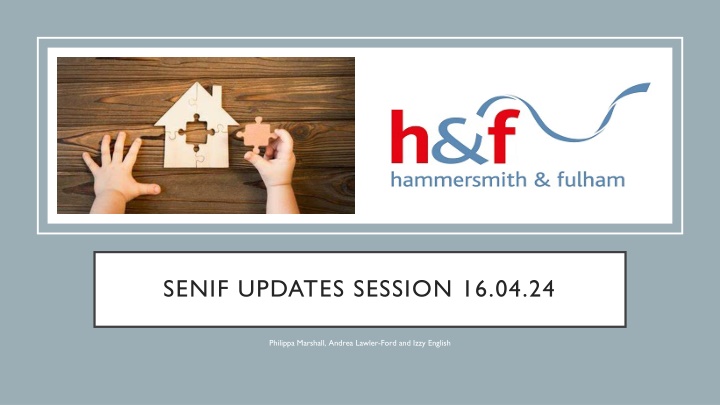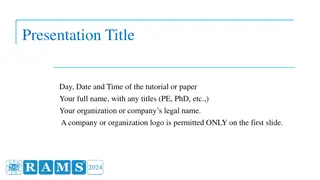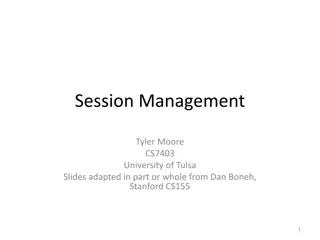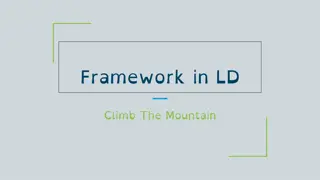
SENIF Updates and New Criteria for Early Years OAP
Explore the latest SENIF updates including new criteria for the Early Years OAP, application deadlines, how to fill in the new SENIF application form, and training on target monitoring evaluation. Stay informed to navigate these changes effectively for inclusive early years education.
Download Presentation

Please find below an Image/Link to download the presentation.
The content on the website is provided AS IS for your information and personal use only. It may not be sold, licensed, or shared on other websites without obtaining consent from the author. If you encounter any issues during the download, it is possible that the publisher has removed the file from their server.
You are allowed to download the files provided on this website for personal or commercial use, subject to the condition that they are used lawfully. All files are the property of their respective owners.
The content on the website is provided AS IS for your information and personal use only. It may not be sold, licensed, or shared on other websites without obtaining consent from the author.
E N D
Presentation Transcript
SENIF UPDATES SESSION 16.04.24 Philippa Marshall, Andrea Lawler-Ford and Izzy English
AIMS OF THE SESSION To go through the new EY OAP document To understand the new SENIF criteria To clarify dates for applications To understand how to complete the new SENIF application form To understand how to use and apply target monitoring Evaluation Questions
EARLY YEARS OAP DOCUMENT This document is still in consultation needs to go through governance and we welcome all feedback.
NEW SENIF THIS DOCUMENT IS STILL IN CONSULTATION NEEDS TO GO THROUGH GOVERNANCE AND WE WELCOME ALL FEEDBACK.
UPDATED SENIF BANDS
THE UPDATED CRITERIA
APPLICATION DEADLINES
HOW TO FILL IN THE NEW SENIF APPLICATION FORM
TARGET MONITORING EVALUATION (TME) Training for all settings in relation to updated SENIF documents April 2024 Isabella English (Early Years Inclusion Advisor)
AIMS OF THE SESSION To understand what TME is. To know what makes a SMART target. To feel confident using TME to monitor children's progress. To feel confident inputting TME into the SENIF documents.
WHAT IS TME Using Target Monitoring Evaluation helps to understand if what has been put in place is supporting the child as intended, as well as measure its success. A tool to monitor a child s progress A tool to help. understand what works and what doesn t work for a child. A tool to gather data to support the assess plan do review cycle . A tool to show the impact of a specific intervention.
ASSESS, PLAN, DO, REVIEW CYCLE Assess The early years practitioner works together with a child's parents and the setting's SENCO to assess the child's needs. They should regularly assess the child to make sure the right support can be put into place. Where the child makes little or no progress, specialist assessment from outside professionals may be needed. Where outside professionals are not already working with the setting, the SENCO discusses this with the child's parents to get their agreement. Plan Review The child's parents, key person and SENCO agree: The outcomes they are seeking for the child. Target Monitoring Evaluation (TME) can be used, please see the Appendix for how to use it and the template. Interventions and support to be put in place. How they expect the interventions to impact upon the child's progress and a review date. Interventions should: Be strategies and support provided by practitioners with the relevant skills, Include a range of learning opportunities and differentiated activities to meet the outcomes identified for the child, All information should be captured in a Child SEND Support Plan, which includes a section on agreed outcomes and an individual provision plan. The setting works with the child's parents to: review the child's progress in line with the agreed date, evaluate the impact and quality of support (use TME to support this) agree any changes to the outcomes, depending on the child's progress. If outside professionals are involved, they should also be invited to attend regular reviews. Do The practitioner, usually the child's key person, is responsible for supporting the child each day and putting in place the agreed interventions. The setting's SENCO should: Support the key person in assessing the child's response to the actions. Provide advice on how to implement the interventions effectivley.
WHAT DOES IT LOOK LIKE?
Setting Targets: Target setting is an important aspect of monitoring a child s progress. This focuses on setting achievable, developmentally appropriate targets, for each specific child. Targets can be written by the nursery SENCO, the child s key worker) and with the parents. Targets should be set before support is put in place and reviewed after a set period of time (e.g., after 4 weeks). SETTING SMART TARGETS SMART. S: Specific to the child and intervention. M: Measurable ensure that you can measure the impact, e.g., 2/3 times a session . A: Achievable ensure that the target is developmentally appropriate for the child. R: Relevant ensure that all targets are child focused, not adult focused. T: Time-bound include a realistic time scale for the target to be met by.
ARE THESE SMART TARGETS? Develop ____ s attention span. To communicate with visuals. To express his needs. To be able to speak clearly.
EXAMPLES OF SMART TARGETS By the end of the summer term, Miah will be able to attend to 2 items during bucket time on 2/3 occasions when supported by her key worker. By the end of Spring term, Cole will be able to communicate that he needs a drink to a familiar adult by pointing at the water bottles once per session. In four weeks, Essa will be able to join a familiar turn taking game with 2 peers, when supported by an adult, for 5 minutes twice per week. By the end of the half term, Ben will be able to transition from one activity to the next when objects of reference are used by his key person on 2/3 occasions.
INPUTTING INTO THE SENIF SPREADSHEET






















